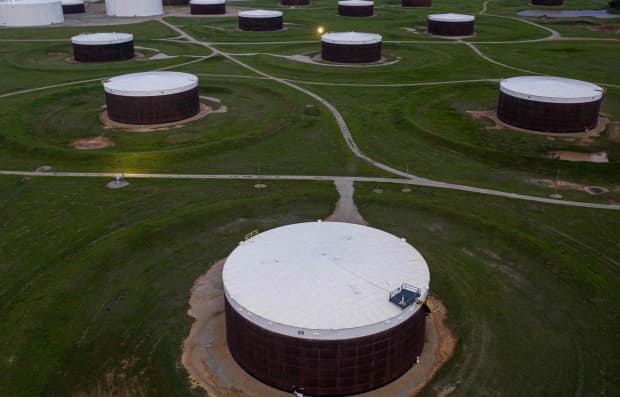This post was originally published on this site

Storage data is on tap Thursday.
Johannes Eisele/Agence France-Presse/Getty Images
Oil futures fell Thursday, with the U.S. benchmark dropping back below $40 a barrel as rising COVID-19 infections result in renewed restrictions on movement in several European countries and the number of cases in the U.S. continued to increase.
West Texas Intermediate crude for November delivery CL.1, -3.31% fell $1.50, or 3.7%, to $39.54 a barrel on the New York Mercantile Exchange. The global benchmark, December Brent crude BRN00, -3.09% dropped $1.51, or 3.5%, to $41.81 a barrel on ICE Futures Europe.
Households in London will be banned from mixing indoors with other households beginning Saturday, joining a number of European cities that have tightened restrictions in an effort to contain a resurgence of the spread of COVID-19. Germany has put new limits on gatherings, while nighttime curfews are being implemented in nine French cities.
“This is still an environment that’s very unfavorable for oil prices, and with increasing restrictions being imposed across Europe and probably following shortly after across the pond, the demand picture is not looking great,” said Craig Erlam, senior market analyst at Oanda, in a note.
“Perhaps I’m missing something but I struggle to see oil managing to hold on at these levels unless a stimulus package in the U.S. is somehow struck ahead of the election,” he said. “Even then, the risks remain tilted to the downside medium term, barring another OPEC+ intervention.”
Oil bulls found little help from data that showed a fall in U.S. crude inventories last week. The American Petroleum Institute, an industry trade group, reported late Wednesday that U.S. crude supplies dropped 5.4 million barrels last week, while gasoline inventories fell 1.5 million barrels and distillate stocks declined 3.9 million barrels, according to sources. API saw crude stocks at the Nymex delivery hub in Cushing, Okla., rise by 2.2 million barrels, sources said.
More closely followed storage data from the Energy Information Administration is due Wednesday morning. Analysts surveyed by S&P Global Platts forecast crude inventories to show a decline of 2.3 million barrels, while gasoline stocks are expected to show a drop of 1.8 million barrels and distillates are forecast to drop 2.5 million barrels.
Oil was buoyed Wednesday after the official Saudi Press Agency said Saudi Arabia’s Crown Prince Mohammed bin Salman and Russian President Vladimir Putin, in a phone call, “agreed on the importance of all oil-producing countries to continue cooperating and abiding by OPEC+ agreement to achieve these goals for the benefit of both producers and consumers.”
OPEC Secretary-General Mohammad Barkindo on Thursday echoed that message, saying that OPEC+ would move to ensure oil prices don’t fall sharply when it meets late next month, Reuters reported.
Barkindo acknowledged a slower-than-expected rebound in oil demand.
“We have to be realistic that this recovery is not picking up pace at the rate we expected earlier in the year,” he said, according to the report. “Demand itself is still looking anemic.”

